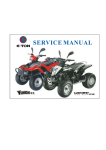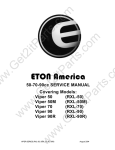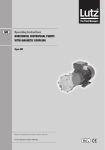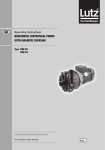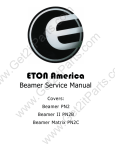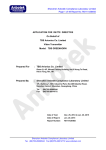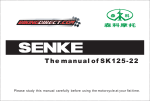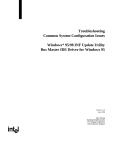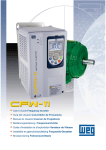Download E-TON Viper 90R Specifications
Transcript
CONTENTS 1. INFORMATION 2. MAINTENANCE 3. ENGINE REMOVAL AND INSTALLATION 4. ENGINE FUEL SYSTEM 5. ENGINE LUBRICATION AND COOLING SYSTEM 6. ENGINE COMBUSTION SYSTEM 7. TRANSMISSION SYSTEM 8. STEERING SYSTEM 9. FRONT WHEEL SYSTEM 10. REAR WHEEL SYSTEM 11. FENDERS AND EXHAUST PIPE 12. ELECTRICAL SYSTEM 13. TROUBLE SHOOTING 1. INFORMATION 1.1 SAFTY 1.2 NOTES 1.3 SPECIFICATION 1.4 SERIAL NUMBER 1.5 TORQUE VALVE 1.1 SAFETY ● Gasoline is extremely flammable and is explosive under certain condition. Do not smoke or allow sparks or flames in your work area. ● Never run the engine in a closed area. The exhaust contains poisonous carbon monoxide gas that may cause loss of consciousness and lead to death. ● The battery electrolyte contains sulfuric acid. Protect your eyes, skin and clothing. If you contact it, flush thoroughly with water and call a doctor if electrolyte gets in your eyes. 1.2 NOTES All information, illustrations, directions and specifications included in this publication are base on the latest product information available at the time of approval for printing. JI-EE Dynamic Technology Industry Co., Ltd. reserves the right to make changes at any time without notice and without incurring any obligation whatever. No part of this publication may be reproduced without written permission. 1.3 SPECIFICATION RXL50 RXL70 RXL90 RXL90R DISPLACEMENT 49.3 ㏄ AIR-COOLING TWO STROKE 68.0 ㏄ 82.5 ㏄ 82.5 ㏄ BORE & STROKE 40.0*39.2 mm 9.2:1 47.0*39.2 mm 8.3:1 5.2 N-m @ 7000rpm 6.3 N-m @ 6000rpm RXL50M ENGINE TYPE COMPRESSION MAXIMUN TORQUE CARBURETOR 50.0*42.0 mm 7.9:1 50.0*42.0 mm 7.9:1 7.0 N-m @ 7500rpm 7.0 N-m 49.3 40.0*39.2 mm 9.2:1 @ 7500rpm 5.2 N-m @ 7000rpm MIKUNI VM16 (for other country) / SW 18 mm-Manual Choke (for America) IGNITION CAPACITOR DISCHARGE STARTING ELECTRIC/KICK START LUBRICATION AUTO OIL INJECTION OIL CAPACITY 1.0 LITER TRANSMISSION AUTOMATIC (C.V.T. V-Belt) CHASSIS OVERALL LENGTH 1470mm (57.9") 1470mm (57.9") 1500mm (59.0") 1500mm (59.0") 1430mm (56.3") OVERALL WIDTH 850mm (33.5") 850mm (33.5") 850mm (33.5") 850mm (33.5") 820mm (32.3") OVERALL HEIGHT 830mm (32.7") 830mm (32.7") 900mm (35.4") 900mm (35.4") 800mm (31.5") SEAT HEIGHT 650mm (25.5") 650mm (25.5") 670mm (26.3") 670mm (26.3") 650mm (25.5") WHEEL BASE GROUND CLEARANCE 930mm (36.1") 930mm (36.1") 930mm (36.1") 930mm (36.1") 930mm (36.1") 110mm (4.3") 95mm (3.7") 120mm (4.7") 130mm (5.1") 110mm (4.3") 108kg 108 kg 113 kg 113 kg 108kg DRY WEIGHT FUEL TANK CAPACITY 4.5 LITERS SUSPENSION FRONT DUAL A-ARM REAR SWING ARM BRAKES FRONT DUAL MECHANICAL DRUM REAR N/A HYDRAULIC DISC TIRES FRONT 16" *8"-7 16" *8"-7 18" *7"-8 18" *7"-8 145/70-6 REAR 16" *8"-7 16" *8"-7 18" *9"-8 18" *9"-8 145/70-6 COLORING Specifications subject to change without notice. Red /Blue /Yellow /Black 1.4 SERIAL NUMBER For this ATV serial; the number of frame and engine are the same position, just like the picture below; The frame serial number is stamped on the front of the frame. The engine serial number is stamped on the left side of the crankcase. Frame serial number Engine serial number For RXL 50/70/90/RXL50M Engine serial number For RXL 90R 1.5 TORQUE VALUES For this ATV serial; the torque values of frame and engine are the same, just like the picture below; ENGINE ● Cylinder head nut 28-30 N.m (20.7-22.1 lbf.ft) ● Spark plug 12-19 N.m (8.9-14.0 lbf.ft) ● Cylinder head bolt 20-30 N.m (14.8-22.1 lbf.ft) ● Alternator bolt 8-12 N.m (5.9- 8.9 lbf.ft) FRAME ● Handlebar upper holder bolt 24-30 N.m (17.7-22.1 lbf.ft) ● Steering shaft nut 50-60 N.m (36.9-44.3 lbf.ft) ● Steering shaft bushing holder nut 24-30 N.m (17.7-22.1 lbf.ft) ● Wheel rim bolt 18-25 N.m (13.3-18.4 lbf.ft) ● Tie rod lock nut 35-43 N.m (25.8-31.7 lbf.ft) ● King pin nut 30-40 N.m (22.1-29.5 lbf.ft) ● Handlebar lower holder nut 40-48 N.m (29.5-35.4 lbf.ft) ● Front wheel bolt 24-30 N.m (17.7-22.1 lbf.ft) ● Front axle nut 55-65 N.m (40.6-47.9 lbf.ft) ● Front brake arm nut 4-7 N.m (3.0- 5.2 lbf.ft) ● Rear brake arm nut 7-12 N.m (5.2- 8.9 lbf.ft) ● Rear axle nut 60-80 N.m (44.3-59.0 lbf.ft) ● Rear wheel bolt 24-30 N.m (17.7-22.1 lbf.ft) ● Exhaust muffler mounting bolt 30-35 N.m (22.1-25.8 lbf.ft) ● Engine hanger bolt 24-30 N.m (17.7-22.1 lbf.ft) 2. MAINTENANCE 2.1 MAINTENANCE DATA 2.2 MAINTENANCE SCHEDULE 2.3 FUEL TUBE 2.4 THROTTLE OPERATION 2.5 THROTTLE CABLE ADJUSTMENT 2.6 AIR CLEANER 2.7 SPARK PLUG 2.8 IDLE SPEED 2.9 DRIVE CHAIN 2.10 BRAKE SYSTEM 2.11 WHEELS AND TIRES 2.12 STEERING SYSTEM 2.13 TOE-IN 2.14 GEAR OIL 2.1 MAINTENANCE DATA SPECIFICATION SPARK PLUG: SPARK PLUG GAP: RECOMMENDED SPARK PLUGS: THROTTLE LEVER FREE PLAY: IDLE SPEED: BRAKE LEVER FREE PLAY: DRIVE CHAIN SLACK FRONT/REAR TIRE PRESSURE TOE-IN 0.6-0.7 mm NGK BPR7HS 5-10 mm 1800±100 rpm 15-25 mm 10-25 mm MIN 2 psi (12.5kpa) 5±10 mm TORQUE VALUES SPARK PLUG TIE-ROD LOCK NUT 12-19 N.m 35-43 N.m ENGINE OIL JASO FC Grade or same degree oil GEAR LUBRICATION OIL SAE 90 2.2 MAINTENANCE SCHEDULE The maintenance internals in the follow table is based upon average riding, conditions. Riding in unusually dusty areas, require more frequent servicing. (For ATV all serial in this service manual) INITIAL SERVICE (First week) REGULAR SERVICE (Every 30 operating days) FUEL LINE THROTTLE OPERATION I I AIR CLEANER C SPARK PLUG I CARBURETOR IDLE SPEED I I DRIVE CHAIN I, L I, L BRAKE SHOE WEAR BRAKE SYSTEM I I NUT, BOLT, FASTENER I I WHEEL I I STEERING SYSTEM SUSPENSION SYSTEM C.V.T. AIR FILTER C GEAR OIL REVERSE GEAR OIL-RXL90R Note – I: Inspect and Clean, Adjust, Lubricate or Replace, if necessary C: Clean L: Lubricate R: Replace EVERY YEAR I I I I R R 2.3 FUEL TUBE Inspect the fuel lines for deterioration, damage or leakage and replace if necessary. (For RXL50 / 90) (For RXL70 / RXL90R / RXL50M) 2.4 THROTTLE OPERATION Inspect for smooth throttle lever full opening and automatic full closing in all steering positions. Inspect if there is no deterioration, damage or kinking in the throttle cable, replace it if necessary. Check the throttle lever, free play is 5-10 mm at the tip of the throttle lever. Disconnect the throttle cable at the upper end. Lubricate the cable with commercially lubricant to prevent premature wear. 2.5 THROTTLE CABLE ADJUSTMENT Slide the rubber cap of the adjuster off the throttle Housing, loosen the lock nut and adjust the free play of the throttle lever by turning the adjuster on the throttle housing. Inspect the free play of the throttle lever. 2.6 AIR CLEANER Unscrew the air cleaner cover screws. Pull out the air filter element from the air cleaner case. Wash the element in non-flammable solvent, squeeze out the solvent thoroughly. Let it dry. Soak the filter element in gear oil and then squeeze out the excess oil. Install the element into air cleaner carefully. 2.7 SPARK PLUG This spark plug located at the front of the engine. Disconnect the spark plug cap and unscrew the spark plug. Check the spark plug electrodes for wearness. Change a new spark plug if the electrodes and insulator tip appear unusually fouled or burned. Discard the spark plug if there is apparent wear or if the insulator is cracked or chipped. The spark plug gap shall keep in 0.6-0.7mm. With the sealing washer attached, thread the spark plug in by hand to prevent cross threading. Tighten the spark plug with 12-19 N.m 2.8 IDLE SPEED Connect an engine speed meter. Warm up the engine, 10 minutes are enough. Turn the idle-speed adjust screw on the carburetor to obtain the idle speed. “Turn in” (clockwise) will get higher speed. “Turn out” (counter clockwise) will get lower speed. IDLE SPEED: 1800±100 rpm 2.9 DRIVE CHAIN Inspect the chain slack. The standard is 10-25mm. Adjust the chain slack. Loose the lock bolts (4 pcs) then adjust the drive chain slack by turn the adjusting nut. Tighten the four lock bolts. When the drive chain becomes very dirty, it should be removed, cleaned and lubricated by specify lubricator. Using commercial chain lubricant to lubricate the drive chain. Clean the drive chain with kerosene and wipe it dry. Inspect the drive chain for possible wear or damage. Replace the chain, if it is worn excessively or damaged. Inspect the sprocket teeth, if it is excessive wear or damage, replace it. Inspect the chain-tensioned roller. Replace it, if necessary. 2.10 BRAKE SYSTEM Inspect the front brake lever and cable for excessive play or other damage. Replace or repair if necessary. Measure the free play of the brake lever at the end of the brake lever. The standard of free play is 15-25 mm. (For RXL50 / 90 / RXL90R, the ATV RXL50M doesn’t have the front brake lever. ) For RXL50M, because it have parking brake in rear tire. So, its controller is at the handler bar right side. Inspect the rear brake lever and cable for excessive play or other damage. Replace or repair if necessary. Measure the free play of the rear brake lever at the end of the lever. The standard is 15-25 mm. (For all type) 2.11 WHEELS AND TIRES Inspect the tire surfaces for cuts, nails or other sharp objects. Check the tire surfaces at cold tire condition. The standard of tire pressure is 2.2±0.3 psi. (0.15 kgf/cm2) 2.12 STEERING SYSTEM Check the free play of the steering shaft with the front wheels, turned straight ahead. When there is excessive play, inspect the tie-rod, kingpin bushing and ball joint. 2.13 TOE-IN Let the vehicle on level ground and the front wheels facing straight ahead. Mark the centers of the tires to indicate the axle center height. Measure the distance between the marks. Carefully move the vehicle back, let the wheels have turned 180 °, so the marks on the tires are aligned with the axle center height. Measure the distance between the marks. Calculate the difference in the front and rear measurements. Toe-in: 5±10mm If the toe-in is out of standard, adjust it by changing the length of the tie-rods equally by turning the tie-rod while holding the ball joint. Tighten the lock nuts. Torque: 35-43 N.m 2.14 GEAR OIL Gear oil needs to be changed every year. There is a gear oil release bolt at the rear of engine. Unscrew this release bolt and can let the dirty oil flow out. The re-add oil hole is on the engine case beside gearbox. (CAUTION: Only the ATV RXL 90R must add the reverse oil) 3. ENGINE REMOVAL AND INSTALLATION 3.1 SERVICE INFORMATION 3.2 ENGINE REMOVAL 3.3 ENGINE INSTALLATION 3.1 ENGINE SHALL BE REMOVED IN THE CONDITIONS OF NECESSARY REPAIRMENT OR ADJUSTMENT TO THE TRANSMISSION AND COMBUSTION SYSTEM ONLY 3.2 ENGINE REMOVAL Remove the seat and rear fender. (Chapter 11) Remove the spark plug cap from the spark plug. Remove the exhaust pipe. Disconnect the carburetor cable by unscrew two screws on top of the carburetor. Take off oil pump cable from the oil pump control plate. Oil pump is under the right side of engine. Disconnect the wire connectors. There are three connectors for carburetor auto-choke, starter motor and generator respectively. Remove the drive chain cover. This is under the chain. Remove the drive chain retaining clip and master link, and remove the drive chain. Remove the three engine hanger nuts and bolts. Remove the engine from the right side of frame. (The pictures of right side are for ATV RXL 50 / 70 / 90 and RXL 50M) (The right side picture is for ATV RXL 90R) 3.3 ENGINE INSTALLATION Engine installation is essentially the reverse order of removal. The torque of engine hanger bolt is 24-30 Nm Route the wires and cable in reverse order properly. 4. ENGINE FUEL SYSTEM 4.1 TROUBLESHOOTING 4.2 FUEL TANK 4.3 CARBURETOR 4.1 TROUBLESHOOTING ENGINE CAN NOT START ★ NO FUEL IN TANK ★ NO FUEL TO CYLINDER ★ TOO MUCH FUEL GO INTO CYLINDER ★ NO SPARK AT PLUG ★ AIR CLEANER CLOGGED ENGINE IDLES UNSTEADY, STALLS OR RUNS POORLY ★ UNPROPER ADJUSTMENT TO THE IDLE SPEED SCREW ★ IGNITION MALFUNCTION ★ FUEL/AIR MIXTURE RATIO NO GOOD ★ AIR CLEANER DIRTY ★ INSULATOR LEAKS ★ FUEL TANK CAP BREATHING HOLE CLOGGED LEAN MIXTURE ★ FUEL JET OF CARBURETOR CLOGGED ★ FUEL TANK CAP BREATHING HOLE CLOGGED ★ FUEL FILTER CLOGGED ★ FUEL FLOWS IN THE TUBE UNSMOOTHLY ★ FLOAT LEVEL IN CARBURETOR TOO LOW RICH MIXTURE ★ FLOAT NEEDLE VALVE IN CARBURETOR FAULTY ★ FLOAT LEVEL TOO HIGH ★ AIR DUCT IN CARBURETOR IS CLOGGED ★ AIR CLEANER DIRTY 4.2 FUEL TANK REMOVAL Remove the seat and rear fender. Disconnect the fuel line from the carburetor. Remove the fuel tank cap and front fender. Unscrew the fuel tank fixed bolts. Note: Keep gasoline away from flames or sparks. Wipe up spilled gasoline at once. 4.3 CARBURETOR REMOVAL Remove the air cleaner. Disconnect the fuel line and auto-choke electric wire. Unscrew the intake pipe mounting bolts at the carburetor then removes the carburetor. Note: Turn fuel cup on (off) position Remove the carburetor cap. Remove the throttle cable from the throttle valve while depressing the throttle valve spring. Remove the needle clip retainer, the jet needle and needle clip. Inspect the throttle valve and jet needle surface for wearness, scratches or dirt. DISASSEMBLY Unscrew the float chamber screws and remove the float chamber. Disassembly the float arm pin, float and float needle valve. Inspect the seat of the float needle valve for wear or damage. Disassembly the idle jet, main jet, idle speed adjust screw and idle mixture adjusts screw. Inspect all the jets and screws for wear or damage. Clean the passages and jets with compressed air. ASSEMBLY Clean all parts in solvent and blow it dry with compressed air. Assembly is essentially the reverse order of disassembly. THROTTLE VALVE ASSEMBLY Install the needle clip on the jet needle. Install the jet needle into the throttle valve. Assembly the throttle cable, spring and the throttle valve. Align the throttle valve groove with the idle speed adjust screw and install the carburetor cap to the carburetor. 5. ENGINE LUBRICATION AND COOLING SYSTEM 5.1 ENGINE LUBRICATION SYSTEM 5.2 CAUTION 5.3 OIL PUMP 5.4 COOLING SYSTEM 5.5 TROUBLESHOOTING 5.1 ENGINE LUBRICATION SYSTEM The engine drives the pump gears of oil pump crankshaft. Pump gears rotate the plunger shaft in oil pump. This shaft sent the lubricating oil into the crankcase to mix with the mixture of air-fuel flow evenly. The oil drops and foam cover the cylinder inner wall, piston surface and piston rings. 5.2 CAUTION Having enough oil supply to engine is very important. If the oil quantity is not enough, this engine will be serious scratched, and then this engine will stop, even cannot work again. When this engine is serious scratched, you need to change the piston, piston rings and cylinder together. Also you need to check the combustion system and lubrication system carefully. 5.3 OIL PUMP The quantity of oil that deliver out from oil pump increased by the engine speed and the carburetor throttle open width. Oil pump is under the right side of the engine and connected by a control cable of throttle. 5.4 COOLING SYSTEM The engine-cooling fan sucks the air. The cooling fan is on the right side of engine. The air is forced to flow through cylinder fin and cylinder head. So, the cylinder and piston will not over heat. 5.5 TROUBLESHOOTING NO ENOUGH OIL SUPPLY TO ENGINE ★ ★ ★ ★ ★ ★ THE OIL LEVEL IN OIL TANK IS TOO LOW. OIL TUBES WERE NOT FIXED WELL. OIL HAS LEAKAGED FROM TUBE ENDS. OIL TUBES WERE BROKEN. OIL TUBES WERE CLOGGED. OIL PUMP CANNOT WORK. ALWAYS INSUFFICIENT OIL LEVEL IN LUBRICATE OIL TANK ★ EXTERNAL OIL LEAKS ★ WORN CYLINDE HEAD GASKET ★ WORN PISTON RINGS 6. ENGINE COMBUSTION SYSTEM 11.1 TROUBLESHOOTING 11.3 CYLINDER AND PISTON INSPECTION 11.2 CYLINDER AND PISTON REMOVAL 11.4 INSTALLATION 6.1 TROUBLESHOOTING LOW COMPRESSION ★ CYLINDER HEAD HEAD GASKET LEAKING OR DAMAGED WARPED OR CRACKED CYLINDER HEAD ★ CYLINDER OR PISTON RINGS WORN OUT HIGH COMPRESSION ★ EXCESSSIVE CARBON BUILD-UP ON PISTON HEAD OR IN COMBUSTION CHAMBER EXCESSIVE NOISE ★ PISTON AND CYLINDER WORN OUT ★ EXCESSIVE CARBON BUILD-UP EXCESS SMOKE ★ CYLINDER OR PISTON RINGS WORN OUT ★ IMPROPER INSTALLATION OF PISTON RINGS ★ PISTON OR CYLINDER WALL SCORED OR SCRATCHED OVERHEATING ★ EXCESSIVE CARBON BUILD-UP ON THE PISTON OR COMBUSTION CHAMBER ★ ENGINE COOLING SYSTEM (FAN, CYLINDER COVER…) WORKS BADLY. ★ OIL SUPPLY IS OUT OF ORDER. ★ WRONG IGNITION TIMING 6.2 CYLINDER AND PISTON REMOVAL Remove the seat and rear fender. Remove the exhaust pipe. Remove the spark plug cap. Disconnect the wire. Drag out the engine. Disassembly the air cleaner and carburetor. Remove the intake pipe mounting bolts. Remove the cylinder bolt nuts. Remove the cylinder head. Remove the cylinder carefully, then you can see the whole piston. Remove one piston pin clip. Remove the piston and piston pin. Spread each piston ring and remove it by lifting up at a point just opposite the gap. Note: Don’t let the clip drop into engine crankcase. 6.3 CYLINDER AND PISTON INSPECTION Inspect the cylinder bore for wear or damage. Measure the cylinder inner diameter at three levels in X and Y-axis. Taper limit: 0.10 mm Out of round: 0.10 mm Check the cylinder head mating surface for warp with a straight edge and feeler gauge. Service limit: 0.10 mm Insert each piston ring into the cylinder, and measure the end gap. Service limit: 0.5 mm Measure the clearance between ring and groove. Service limit: 0.09 mm Measure the piston outer diameter at 10 mm high from the skirt’s bottom. Service limit: RXL RXL RXL 50 ㏄ 70 ㏄ 90 ㏄ 90R ㏄ 50M ㏄ 39.9 mm 46.9 mm 49.9 mm 49.9 mm 39.9 mm Measure the piston pin bore, and the piston pin outer diameter. Pin outer diameter service limit: RXL RXL RXL 50 ㏄ 90R ㏄ 50M ㏄ 90 ㏄ 50 ㏄ 9.96 mm 9.96 mm 1.96 mm 1.96 mm 9.96 mm Pin bore service limit: RXL RXL RXL 50 ㏄ 90R ㏄ 50M ㏄ 90 ㏄ 50 ㏄ 10.04 mm 10.04 mm 12.04 mm 12.04 mm 10.04 mm Measure the connecting rod small end inner diameter with a small bore diameter gauge. Service limit: RXL RXL RXL 50 ㏄ 90R ㏄ 50M ㏄ 90 ㏄ 50 ㏄ 14.06 mm 14.06 mm 15.06 mm 15.06 mm 14.06 mm 6.4 INSTALLATION Install the piston rings with the marks facing up. Do not damage the piston rings by spreading the ends too far. Clean the cylinder gasket surface being careful not to drop any gasket material into the crankcase. Apply some oil to inside of the connecting rod small end. Install the piston, piston pin and clip. Install the piston with the arrow mark facing the exhaust pipe. Do not align the piston pin clip end gap with the piston cutout. Install a new cylinder gasket. Apply a thin coat of engine oil to the piston rings and cylinder wall. Install the cylinder, compressing the piston rings. Replace a new cylinder head gasket. Install the cylinder head. Tighten the cylinder-mounting bolt. The torque is 10-14N.m 7. TRANSMISSION SYSTEM 7.1 TROUBLE SHOOTING 7.2 THE PARTS DRAWING OF TRANSMISSION SYSTEM 7.3 SHIFT MECHANISM (INCLUDE C.D.I) 7.4 AUTOMATIC CONTINUOUS VARIABLE TRANSMISSION 7.5 CONTINUOUS VARIABLE TRANSMISSION 7.6 GEAR BOX 7.7 ELECTRIC SELF-STARTER MECHANISM 7.8 KICK STARTER 7.9 DISASSEMBLY AND CHECK OF C.V.T. SYSTEM 7.1 TROUBLESHOOTING ABNORMALLY ACT IN SHIFTING AND CAN’T RESET ★ FAULTY C.D.I ★ FAULTY SHIFT MOTOR ★ FAULTY SENSOR (F, N1, R, N2) ★ FAULTY SHIFT SPRING OR GEAR CAN NOT MOVE AFTER ENGINE START ★ BELT WORN ★ FRONT PULLEY WORN OR BROKEN ★ LINING OF CLUTCH WORN ★ FAULTY SHIFT SPRING CAN NOT RUN AT HIGH SPEED ★ BELT WORN ★ ROLLERS WORN ★ SPRING OF REAR PULLEY IS DISTORTED ENGINE STOP AFTER SHIFT SUCCESSFULLY ★ FAULTY C.D.I THE FUNCTION OF SPEED LIMITED IS ABNORMAL ★ FAULTY C.D.I 7.2 THE PARTS DRAWING OF TRANSMISSION SYSTEM C.V.T Shift Mechanism For RXL 90R Gear Box For RXL 90R 7.3 SHIFT MECHANISM GENERAL For mission repair, the engine must separate from frame. Full stop the vehicle before shifting to forward or reverse. Fill the recommended oil after install the mission cover. Avoid shifting to forward when vehicle is reversing, otherwise it will cause gears set to damage. TROUBLESHOOTING DETECT METHOD CONDITION REASON Detect battery voltage Under 10.5V 1.ACG can't charge 2.Bettery failure CDI signal Compared with good CDI, it is NG CDI failure Wire connect NG 1.Main wire burn down 2.Motor wire come away Detect motor After work 10 seconds without load, Motor failure resistance value not in 2~5Ω Detect sensor No signal 1.Faulty sensor 2.Sensor wire come away OK NG Detect shift gears Inspect appearance fault 1.Faulty linker,gear,roller 2.Faulty shifting spring Detect shift mech. Parts dimension NG 1.Fixed steel ball was faulty or came away 2.Faulty fixed spring 3.Fillister of shifting hub not smooth 4.Head of fork wore 3D DRAWING C.D.I We can find C.D.I under the seat. It include shift control system. Replace it if control system invalid. There is a speed-limited adjuster in the corner. Adjust speed-limited as follows: Speed-Limited Speed-LimitedAdjuster Adjuster C.D.I C.D.I SENSOR Inspect wire for break or damage and check contact. Measure sensor dimension as fig-1 after unscrew sensor. If length is below 30mm, it must be replaced. Smear with loctite 5699 and screw with torque 25 kgf-cm in assembly. Service limits: 30 mm Torque: 30 kgf-cm Sensor N2 Sensor R Sensor N1 Sensor F fig-1 Shift Motor SHIFT MECH. Remove mission side cover and other parts. Check shift gear for wear or damage. Measure open width of shift spring as fig-2. Shift Spring If open width greater than 5mm, it must be replaced. Service limits: 5 mm fig-2 Shift Gear SHIFT MOTOR Disassembly mission side cover, parts of shift mechanism and mission cover. Check shift motor whether the action is normal as follow dat. Voltage Current Torque rpm UNLOAD 12V 0.8A MAX. -- LOADED 12V 2A 2300 0.5 kg-m 1100 Get seal and bearing after disassembly shift motor of mission cover. Check seal and bearing for wear or fatigue. Replace it if necessary. Brush Seal Bearing 7.4 AUTOMATIC CONTINUOUS VARIABLE TRANSMISSION This transmission is the combination of automatic centrifugal clutch and V-belt continuous variable transmission, which can change the transmission ratio automatically. When engine speed increase, the drive pulley will be push to belt by the centrifugal force from six rollers. Then the pitch circle of belt in drive pulley will be larger. The belt at driven pulley is forced to move to the center of shaft, then the radius of pitch circle is decreased. The transmission ratio is therefore altered by the alteration of pitch circle’s radius. (In the drawing, “H” means high speed, “L” means low speed) 7.5 CONTINUOUS VARIABLE TRANSMISSION V-Belt Made of rubber fiber, resistant to head, pressure and abrasion. The inner side of the Belt is toothed. Drive Pulley Due to the increasing engine speed, the rollers push the movable drive face by centrifugal force. Then the belt is pressed and enlarges its turning radius. The aluminum fan is installed on the exterior of fixed drive face. It can reduce the belt temperature. Driven Pulley Because the revolving radius of V-Belt at the Drive End is enlarged, the Face Comp Movable Drive is squeezed out by the V-Belt at the Driven End to shorten the revolving radius. There is a Torque Cam on the Movable Drive Face. Torque Cam is loaded from outside. When the outside load is higher than the engine’s output, the pulley of fixed shaft and belt slip to make the Movable Drive Face move along the inner side of Cam and compensate to increase to high torque (toward to low speed) and make the engine maintain smooth running with original revolution. 7.6 GEAR BOX (For RXL 90R) Reverse Shaft Comp Sensor Drive Shaft Comp Drum Gear Shift Fork Fork Shaft Counter Shaft Comp Remove mission side cover, parts of shift mechanism and mission cover. Inspect gears for wear, scoring, chipping or break. Replace it if necessary. The gear ratio of front gear composition is about 47 31 × 15 11 The gear ratio of reverse gear composition is about 49 49 31 × × 15 16 11 7.7 ELECTRIC SELF-STARTER MECHANISM Starter Motor is installed on the upper side of engine. The starter motor can act only when the left hand brake is applied. ELECTRIC SELF-STARTER MECHANISM KICK STARTER 7.8 KICK STARTER This kick-starter arm is on the left side of engine. When the kick-starter arm is kicked, the gear of start shaft will drive the kick-starter to revolve the crankshaft to start the engine. After the engine is started, the kick-started will stop transfer the power to the kick-starter driven gear. When the kick-starter lever is released, the kick-starter gear will go back to its original position. 7.9 DISASSEMBLY AND CHECK OF C.V.T. SYSTEM Remove the engine clutch cover, by unscrew the fixed bolts. Check the belt for wear. If necessary, replace the belt. Service limit: 14.6 mm Disassembly the front drive pulley, check the six rollers for wear. If necessary, replace the rollers. 8. STEERING SYSTEM 8.1 THE PARTS DRAWING OF STEERING SYSTEM 8.3 HANDLEBAR 8.2 TROUBLESHOOTING 8.4 STEERING SYSTEM 8.1 THE PARTS DRAWING OF STEERING SYSTEM 8.2 TROUBLESHOOTING HARD STEERING 8.3 HANDLEBAR REMOVAL Remove the throttle lever housing on the right handle bar. Remove brake lever bracket. (The picture of right side is for ATV RXL 50/90 and RXL 90R) ★ ★ ★ ★ ★ FAULTY TIRE STEERING SHAFT HOLDER TOO TIGHT INSUFFICIENT TIRE PRESSURE FAULTY STEERING SHAFT BEARINGS DAMAGED STEERING SHAFT BEARING (The picture of right side is for ATV RXL 50M) Remove engine switch housing on the left handle bar. Remove rear brake level bracket. (For all type) Remove the bolts attaching the upper holder cover. Remove the handlebar holder and handlebar. INSTALLATION Put the handlebar on the lower holders. Make sure the handlebar punch mark with the tops of the handlebar lower holders. Install the handlebar upper holders with the L or R marks facing forward. Tighten the forward bolts first, and then tighten the rear bolts. Install the handlebar upper holder’s cover. Install the switch housing, aligning the boss with the hole. Tighten the upper screw first then tighten the lower one. Install the rear brake lever bracket, aligning the boss with the hole. Tighten the screw securely. (The picture of right side is for ATV RXL 50/90 and RXL 90R) Aligning the split line of the throttle housing and holder with the punch mark. Tighten the screw securely (The picture of right side is for ATV RXL 50/90 and RXL 90R) (The picture of right side is for ATV RXL 50M) 8.4 STEERING SYSTEM (The ATV RXL and KXL and MXL have the same system) REMOVAL OF KINGPIN AND TIE-ROD Remove the front wheels and brakes plates. Remove the four self-lock nuts from the tie-rod ball joints and take off the two tie-rods. Take off the rubber cap on the kingpin and remove the cotter pins on the kingpin. Unscrew the castle nut and remove the kingpin. TIE-ROD INSPECTION Inspect the tie-rod for damage or bending. Inspect the ball joint rubbers for damage, wear or deterioration. Turn the ball joints with fingers. The ball joints should turn smoothly and quietly. KINGPIN INSPECTION Inspect the kingpin for damage or cracks. Measure the kingpin outer diameter. Upper minimum limit: Ø15.40 mm Lower minimum limit: Ø16.90 mm KINGPIN BUSHING INSPECTION There are two bushing in the sleeve of front swing arm, the upper and lower bushing. Check the kingpin bushings for wear or damage. Measure the inner diameter of the bushings. Upper minimum limit: Ø15.69 mm Lower minimum limit: Ø17.19 mm STEERING SHAFT REMOVAL Remove the handle bar and handle bar cover. (see paragraph 8-1) Remove the front fender. (see paragraph 11-1) Unscrew the steering shaft fixed out below shaft. Pull steering shaft carefully. BUSHING INSPECTION Remove the steering shaft. Remove the bushing from the shaft. Inspect the bushing for damage or wear, replace if necessary. Measure the bushing inner diameter. Maximum limit: Ø22.8 mm STEERING SHAFT INSPECTION Inspect the steering shaft for damage or cracks. Measure the steering shaft outer diameter in the location of the bushing. Minimum limit: Ø22.0 mm STEERING SHAFT BEARING INSPECTION Turn the shaft bearing with finger. The bearing is on the front part of frame. The bearing should turn smoothly and quietly. Also check that the bearing outer race fits in the holder. Replace the bearing if necessary. INSTALLATION OF STEERING SHAFT Install the steering shaft with the bushing. Apply grease to the bushing. Install the bushing holder and tighten the nuts. Torque: 24-30 N.m Install the steering shaft nut and tighten it. This nut is under this steering shaft. Torque: 50-60 N.m INSTALLATION OF TIE-ROD Install the ball joint with “ L” mark on the steering shaft side. Install the tie-rod with the mark on the wheel side. Let the distance between the ball joints be 164 mm for RXL 50/70/90 and RXL90R and RXL50M. This is temporary setting. INSTALLATION OF KINGPIN Use grease to the kingpin lower dust seal lips and install it. Pump grease to bushing and install the kingpin. Tighten the kingpin nut, the setting torque is 30-40 N.m. Fix the waterproof rubber cap. Temporarily, set the distance 147mm between the ball joints. Install the tie-rod and tighten the nuts. The setting torque: 35-43 N.m Install the front brake. Install the front wheel. Adjust the toe in. (see chapter 2) 9. FRONT WHEEL SYSTEM 9.1 THE PARTS DRAWING OF FRONT WHEELS SYSTEM 9.2 TROUBLESHOOTING 9.3 FRONT WHEEL 9.4 FRONT BRAKES 9.1 THE PARTS DRAWING OF FRONT WHEELS SYSTEM FOR RXL 50 FOR RXL 70 AND RXL 50M FOR RXL 90 AND RXL 90R 9.2 TROUBLESHOOTING FRONT WHEEL WOBBLING ★ ★ ★ ★ FAULTY TIRE WORN FRONT BRAKE DRUM BEARING BENT RIM AXLE NUT NOT TIGHTENED PROPERLY BRAKE DRAG ★ ★ INCORRECT BRAKE ADJUSTMENT STICKING BRAKE CABLE POOR BRAKE PERFORMANCE ★ ★ ★ ★ BRAKE SHOES WORN WORN BRAKE DRUM BRAKE LININGS OILY, GREASY OR DIRTY IMPROPER BRAKE ADJUSTMENT 9.3 FRONT WHEEL REMOVAL Raise the front wheels off the ground by placing a block under the frame. Remove the front wheel nuts, washer and wheels. INSTALLATION Install and tighten the four-wheel nuts Torque: 50-60 N.m Remember put a cotter pin in the castle nut. 9.4 FRONT BRAKES FRONT BRAKE INSPECTION Remove the front wheel. Remove the brake drum. (In this section, because of ATV RXL 50M has no front brake. So it is only for ATV RXL 50 / 70 / 90 and RXL 90R.) Measure the brake lining thickness. The minimum limit: 1.5 mm If they are thinner than the minimum limit, replace the brake linings. Measure the brake drum inner diameter. The maximum limit: 86 mm Turn the inner race of each bearing with fingers. The bearings should turn smoothly and quietly. If the race does not turn smoothly or quietly, remove and discard the bearings . BRAKE PANEL REMOVAL Disconnect the brake cable from the brake arm. Remove the brake panel from the knuckle. Remove brake arm and cam. Remove return spring. Remove indicator plate and felt seal. INSTALL BRAKE PANAL Apply grease to the brake cam and anchor pin and install the cam in the brake panel. Soak the felt seal in the engine oil and install the seal on the brake cam. Install the brake arm on the cam by aligning the punch mark and the groove on the cam. Tighten the brake arm bolt and nut. Torque: 4-7 N.m Install the return spring. Install the brake panel on the knuckle. Connect the brake cable to the brake arm. Install the brake arm cover. Tighten the screws securely. Position the brake shoes in their original locations and install the brake shoe spring. Install the brake drum and front wheel. Install the castle nut and cotter pin. 10. REAR WHEEL AND BRAKE SYSTEM 10.1 THE PARTS DRAWING OF REAR WHEEL SYSTEM 10.2 TROUBLESHOOTING 10.3 DRIVE MECHANISM 10.4 HYFRAULIC DISC BRAKE SYSTEM 10.1 THE PARTS DRAWING OF REAR WHEEL SYSTEM FOR ATV RXL50 FOR ATV RXL90 AND RXL90R FOR ATV RXL70 AND RXL50M FOR RXL 50/70/90/90R FOR RXL 50M 10.2 TROUBLESHOOTING BAD BRAKE PERFORMANCE VIBRATION OR WOBBLE BRAKE DRAG ★ ★ ★ ★ ★ ★ ★ ★ ★ ★ ★ ★ ★ 10.3 DRIVE MECHANISM REMOVAL AND INSPECTION Remove the rear wheel Let the rear wheels off the ground. Release the cotter pin, axle nut and washer. Release the wheel and wheel hub. Remove the drive chain under cover. Disassemblies the chain retaining clip and master link. BRAKE SHOES ARE WORN BAD BRAKE ADJUSTMENT BRAKE LININGS ARE OILY, GREASY OR DIRTY BRAKE DRUMS ARE WORN BRAKE ARM SETTING IS IMPROPERLY ENGAGE AXLE IS NOT TIGHTENED WELL BENT RIM AXLE BEARINGS ARE WORN FAULTY TIRES REAR AXLE BEARING HOLDER IS FAULTY INCORRECT BRAKE ADJUSTMENT STICKING BRAKE CAM STICKING BRAKE CABLE Disassembly the driven sprocket, axle and sprocket collar. Check the driven sprocket for damage or wear. Let the rear axle lie in V-blocks and check the run out. The run out limit is 0.5 mm Check the turning of bearing with fingers. The bearings should turn smoothly and quietly. Replace if necessary. INSTALLATION Add grease to the dust seal lips and install dust seals. Assembly the rear axle and the driven sprocket. Assembly the drive chain on the driven sprocket. Assembly the master link and retaining clip. Note the retaining clip direction. Install the drive chain cover. Assembly the chain under cover. Assembly the wheel. Tighten the rear axle nut with 60-80 N.m. Install a new cotter pin. Adjust rear brake level free play. Adjust chain slack. 10.4 HYFRAULIC DISC BRAKE SYSTEM To replace brake disc To replace brake disc Remove the rear left tire Unscrew the two bolts shown on the photo and remove caliper Unscrew the rear wheel axle nut and then remove the mounting seat of the disc Unscrew bolts and remove the brake disc Check the thickness of disc and replace a new one if the thickness less than 3mm TO REPLACE THE BRAKE SHOE Remove the rear left tire Unscrew the two bolts shown on the photo and remove caliper Press the plate to the end Remove the brake shoe as shown Check the thickness of brake shoe and replace a new one if the thickness less than 1mm. Press the piston to the end prior to installation of brake shoe Piston TO REPLACE THE BRAKE HYDRAULIC OIL Unscrew the bolts and open the cover. Unscrew the bolt and drain out the used oil drain. Fasten the bolt after the used oil being drained out completely. Add the brake oil (Dot 3 or Dot 4) Keep oil level at least half of the cup to avoid air gets into brake system, such like caliper and tube Unscrew the bolt to vent air from brake system. Fasten the bolt if there isn’t any air in the brake system. Pull left brake lever slightly to extract air from brake system Fill the brake oil to the level shown on the cup when no air comes out Assemble the cover PARKING BRAKE ASSEMBLY- RXL 50R In RXL 50R, it has a parking brake in the rear brake. It uses another clipper to make brake stopping, and the controller is on handle bar right side. The other types are different. REMOVAL THE PARKING BRAKE SHOE After removing the tire, using the power tool There are two brake caliper fixing bolt on the back of the plate. Use wrench to remove those two bolts, you can take the whole caliper out. After removing the rear brake caliper, release the brake cable-fixing nut. Then you can take apart the parking brake caliper. When replace the brake shoes, it must use hammer and punch to impact the pins out. Thus two brake shoes will be separated to maintenance. After finishing whole repair procedures, to install all parts in reverse steps above. 11. FENDERS AND EXHAUST PIPE 11.1 FENDERS DRAWING 11.2 HOW TO REMOVE THE FENDERS 11.3 EXHAUST PIPE DRAWING 11.4 EXHAUST PIPE REMOVE 11.5 EXHAUST PIPE INSTALLATION 11.1 FENDERS DRAWING All type has the same model below 11.2 HOW TO REMOVE THE FENDERS Unscrew two plastic bolts, you can remove the front body covers as picture 1 & 2. Picture 1 Picture 2 You should remove the seat before removing the front and rear fender. Unscrew the bolts as pictures 3 & 4 then you can remove the rear R/L fender. Picture 3 Picture 4 As picture 5 you can remove the rear R/L fender. Picture 5 As picture 6 unscrew these four bolts then you can remove the rear body fender. Picture 6 Before remove the front body cover you should remove the handle bar cover firstly. Secondly, you should disassembly the front and rear brake cable and throttle cable, then disassembly the handle bar. As picture 7 unscrew the bolt then you can remove the front body fender. Picture 7 As picture 8 & 9 unscrew these three bolts then you can remove the front R/L fender. Picture 8 Picture 9 11.3 EXHAUST PIPE DRAWING This pipe is for ATV RXL 50/70/90 and RXL 90R and RXL 50M serial 11.4 EXHAUST PIPE REMOVE Do not service the exhaust pipe while they are hot. Unscrew the exhaust pipe nuts that fixed with engine. Remove the exhaust pipe mounting bolts that beside the muffler body. Remove the exhaust pipe carefully. 11.5 EXHAUST PIPE INSTALLATION (There are three screw bolts in the vehicle frame. One is on the engine exhaust pipe end, and the other Is on the side of the transmission, another is on the End of vehicle frame.) Installation is the reverse order of removal. Torque: Exhaust muffler bolts 30-35 N.m After installation; make sure that there are no exhaust leaks. 12. ELECTRICAL SYSTEM 12.1 TROUBLESHOOTING 12.2 IGNITION COIL 12.3 BATTERY CAUTION 12.4 BATTERY INSPECTION 12.5 CHARGING 12.6 REMOTE CONTROLLER 12.7 WIRING DIAGRAMS 12.1 TROUBLESHOOTING ENGINE STARTS BUT STOPS ★ IMPROPER IGNITION TIMING ★ FAULTY SPARK PLUG NO SPARK AT PLUG ★ ★ ★ ★ ★ ENGINE STARTS BUT RUNS POORLY ★ IGNITION PRIMARY CIRCUIT Faulty generator Faulty CDI unit Faulty alternator exciter coil Loosen contacted terminals Faulty ignition coil ★ IGNITION SECONDARY CIRCUIT Faulty plug Loosen contacted spark plug wire ★ IMPROPER IGNITION TIMING Faulty generator Faulty CDI unit CHARGING SYSTEM FAILURE ★ LOOSE, BROKEN OR SHORTED WIRE ★ FAULTY ALTERNATOR ★ FAULTY IGNITION SWITCH ENGINE INTERMITTENT POWER ★ LOOSE BATTERY CONNECTION ★ LOOSE CHARGING SYSTEM CONNECTION STARTER MOTOR WILL NOT TURN ★ DEAD BATTERY ★ FAULTY IGNITION SWITCH ★ LOOSE OR DISCONNECTED WIRE STARTER MOTOR AND ENGINE TURN, BUT ENGINE DOES NOT START ★ FAULTY IGNITION SYSTEM ★ ENGINE PROBLEMS ★ FAULTY ENGINE STOP SWITCH REMOTE CONTROLLER INCAPABLE ACTION TO MAKE ENGINE UNABLE RUNNING ★ FAULTY REMOTE CONTROLLER ★ SCANTY CONTROLLER BATTERY ELECTRIC ENGINE STOP SWITCH AT “ OFF “ FAULTY IGNITION COIL FAULTY GENERATOR FAULTY CDI UNIT POOLY CONNECTED: Between CDI and ignition coil Between alternator and CDI unit Between CDI and engine stop switch Between ignition coil and spark plug Between generator and CDI unit 12.2 IGNITION COIL (ATV RXL 50/90 and KXL 90 and MXL 50 all have the same model in this chapter) Remove the spark plug cap from the spark plug. Disconnect the ignition coil primary wire. Measure the primary coil resistance. STANDARD: 0.1 - 0.3Ω(20℃) Measure the secondary coil resistance with the spark plug cap in place. STANDARD : 7.4 – 12 kΩ(20℃) IGNITION TIMING The ignition advance is 15°± 3°/4000rpm The Capacitive Discharge Ignition (CDI) system is factory pre-set and does not require adjustment. ALTERNATOR EXCITER COIL Remove the seat / rear fender and front fender. (see chapter 10) Disconnect the exciter coil wire. Measure the resistance between the yellow / red wire and ground. STANDER : 0.5-0.6Ω (AT 20℃, 68℉) Measure the resistance between the white wire and ground. STANDER : 0.48-0.72Ω (AT 20℃, 68℉) Measure the resistance between the black / red wire and ground. STANDER : 640-960Ω (AT 20℃, 68℉) Measure the resistance between the white / red wire and ground. STANDER : 400-600 or 90-130Ω (AT 20℃, 68℉) 12.3 BATTERY CAUTION The battery gives off explosive gases; keep sparks, flames and cigarettes away. Provide adequate ventilation when charging or using the battery in an open area. The battery contains sulfuric acid (electrolyte). Contact with skin or eyes may cause severe burns. Wear protective clothing and a face shield. Electrolyte is poisonous. If swallowed drink large quantities of water or milk and call a physician. 12.4 BATTERY INSPECTION Battery is under the seat, you can see this battery from the left side. Measure the battery voltage using a voltmeter. VOLTAGE: Fully charged: 13.1 V Undercharged: Below 12.0 V BATTERY REMOVAL Remove the battery holder bolt nuts. Disconnect the negative cable and then the position cable and remove the battery. BATTERY INSTALLATION Install the battery in the reverse order of removal. After installing the battery, coat the terminals with clean grease. 12.5 CHARGING Connect the charge positive cable to the battery position terminal. Connect the charge negative cable to the battery negative terminal. Using 0.9A-charging current about 5 hours. (Normal charging) Or using 4A-charging current about 1 hour. (Quick charging) Keep flames and sparks away from a battery being charged. Quick charging should be limited to an emergency; Normal charging is preferred. 12.6 REMTOTE CONTROLLER If the remote controller was lost and faulty or its cells empty. You must change cells or buy a new one and follow the steps below to make the controller function correctly. It is also application in ATV that has remote controller. First turn the switch off and take the front center cover apart. Find out the receiver pin on the right side of front vehicle. Use the wire clip to connect the receiver pin and vehicle frame ground. After connecting the wire link, you must finish controller adjust frequency in ten seconds. Turn on the switch. Take a new remote controller and press any button one time for one second to adjust the frequency of controller. Then waiting ten seconds later pull out end of wire clip from receiver pin or frame ground. Before testing the remote controller, make sure the engine stop switch on the left handle bar is on position. Then press both buttons of the controller may make the vehicle running normally. If the vehicle engine does not run, please repeat the steps above carefully. 12.7 WIRING DIAGRAMS The wiring diagram above is for RXL 50 / 90 The wiring diagram above is for RXL 70 / 90 and RXL 50M VIPER 90R 2-Takter 13.TROUBLESHOOTING 13.1 ENGINE DOES NOT START 13.4 LOSS POWER 13.2 POOR PERFORMANCE AT LOW AND IDLE SPEEDS 13.5 POOR HANDLING 13.3 POOR PERFORMANCE AT HIGH SPEED 13.1 ENGINE DOES NOT START POSSSIBLE REASON N.G. CHECK FUEL FLOW TO CARBURETOR O.K. SPARK TEST N.G. WEEK OR NO SPARK O.K. N.G. TEST CYLINDER COMPRESSION LOW COMPRESSION O.K. ★ ★ ★ ★ No fuel In fuel tank Clogged float valve Clogged fuel tank cap breather hole Clogged at fuel tube ★ ★ ★ ★ ★ ★ ★ ★ ★ ★ Faulty spark plug Fouled spark plug Faulty CDI unit Faulty alternator Faulty engine stop switch Poorly connected ,broken or shorted wires Broken or shorted ignition coil Broken or shorted spark plug wire Faulty pulse generator Faulty ignition switch ★ ★ Worn cylinder and piston rings Damaged cylinder head gasket ★ ★ ★ ★ ★ Auto choke off or damaged Auto choke power wire disconnected Improperly adjusted air screw Improperly ignition timing Fuel / air mixture ratio is too lean ★ ★ ★ ★ ★ Carburetor flooded Improperly adjusted air screw Fuel / air mixture ratio too rich Auto choke stuck or damaged Air cleaner dirty ENGINE START BUT STOPS START THE ENGING ENGINE DOES NOT FIRE REMOVE AND INSPECT SPARK PLUG WET PLUG 13.2 POOR PERFORMANCE AT LOW AND IDLE SPEEDS POSSIBLE REASON N.G. CHECK IGNITION TIMING ★ Faulty CDI unit or pulse generator ★ Improperly adjusted air screw ★ ★ Deteriorated insulator o-ring Loose carburetor ★ ★ ★ ★ ★ ★ ★ ★ ★ Loose or disconnected ignition system wires Faulty ,carbon or wet fouled spark plug Faulty alternator Faulty CDI unit Faulty ignition switch Faulty ignition coil Faulty pulse generator Broken or shorted spark plug wire Faulty engine stop switch O.K. CHECK carburetor AIR SCREW ADJUSTMENT N.G. O.K CHECK FOR LEAKING INTAKE PIPE N.G O.K. PERFORM SPARK TEST WEEK OR INTERMITTENT SPARK 13.3 POOR PERFORMANCE AT HIGH SPEED POSSIBLE REASON N.G. CHECK IGNITION TIMING O.K. CHECK FUEL TUBE AT CARBURETOR ★ Faulty CDI unit Faulty pulse generator ★ ★ ★ ★ Lack of fuel in tank Clogged fuel line Clogged fuel valve Logged fuel tank breather hole ★ Clean with high pressure air gun ★ Clean the filter ★ FUEL FLOW RESTRICTED FUEL FLOWS FREELY REMOVE CARBURETOR CHECK FOR CLOGGED JETS CLOGGED NOT CLOGGED CHECK AIR CLEANER FILTER ELEMENT DIRTY 13.4 LOSS POWER POSSIBLE REASON RAISE WHEELS OFF GROUND AND SPIN BY HAND DOES NOT SPIN FREELY SPIN FREELY CHECK TIRE PRESSURE PESSURE LOW CHECK TIRE ★ ★ ★ ★ Brake dragging Drive chain too tight Damaged wheel bearing Wheel bearing needs lubrication ★ ★ Punctured tire Faulty tire valve ★ ★ ★ ★ ★ Fuel / air mixture ratio too rich or lean Clogged in air cleaner Clogged in muffler Restricted fuel flow Clogged fuel tank cap breather hole ★ ★ Faulty pulse generator Faulty CDI unit ★ ★ Leaking head gasket Worn cylinder and piston rings ★ Clean ★ ★ Clean the spark plug Spark plug is incorrect heat range ★ Excessive carbon deposited in Combustion chamber Wrong type of fuel Fuel / air mixture ratio is lean Use of poor quality fuel PRESSURE NORMAL ACCELERATE LIGHTY ENGINE SPEED DOES NOT INCREASE ENGINE SPEED INCREASE N.G. CHECK IGNITION TIMING O.K. TEST CYLINDER COMPRESSION O.K. TOO LOW CLOGGED CHECK CARBURETOR O.K. CHECK SPARK PLUG FOULED OR DISCOLOED O.K. CHECK FOR ENGINE OVERHEATING OVERHEATING ★ ★ ★ O.K. ACCELERATE OR RUN AT HIGH SPEED KNOCKS ★ ★ ★ ★ ★ worn piston and cylinder Fuel / air mixture ratio is lean Wrong type of fuel Ignition timing too advanced Excessive carbon deposited in Combustion chamber 13.5 POOR HANDLING POSSIBLE REASON STEERING IS HEAVY ONE WHEEL IS WOBBLING VEHICLE PULLS TO ONE SIDE ★ ★ Damaged steering bearing Damaged steering shaft bushing ★ Bent rim ★ Improperly installed wheel hub ★ Excessive wheel bearing play ★ Bent swingarm ★ Bent frame ★ Swing arm pivot bushing excessively ★ Worn ★ ★ ★ ★ ★ Bent tie-rod Incorrect tie-rod adjustment Rear tie air pressure incorrect Improper wheel alignment Bent frame





































































